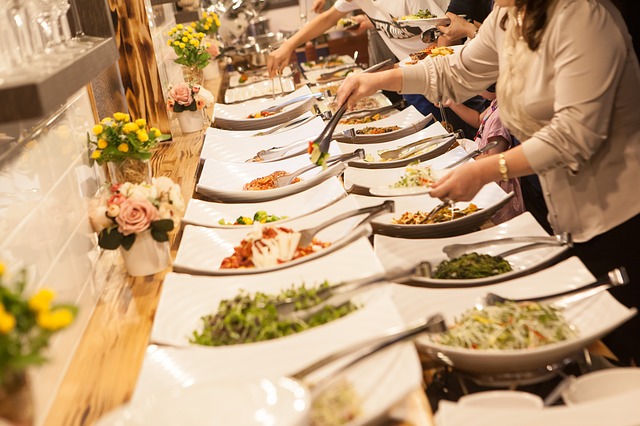Every wedding needs at least two things: the marriage license and food. Feasting is the primary way that humans celebrate major accomplishments and events, and it has been almost since our ancestors started walking upright. The food at your wedding symbolizes many things — the gratitude you have for your loved ones, the bounty that your marriage will bring, etc. — but it also represents a major chunk of your wedding budget.
Fortunately, there are a few different ways you can serve food at your wedding, giving you more control over the costs as well as the look and feel of the reception. Here are some pros and cons of six typical meal options, so you can consider what you want for your wedding:
Sit-down Plates
This option allows guests to remain seated while servers deliver individual plates of food. Typically, sit-down plated meals include a few courses, such as salad, entrée and dessert, and guests choose their options either on their RSVP or from a wedding menu card at the reception. Sit-down plates are easily the most formal of your meal options, which could be a pro or a con depending on your desired wedding atmosphere.
Pros
- All guests get to eat at close to the same time, which prevents some guests from getting antsy or upset while others are tucking in.
- You can structure your reception around the different courses, giving guests time to digest smaller amounts of food while enjoying activities like toasts and dancing.
- Caterers know exactly how much food to prepare because you can deliver a guest list and dinner orders in advance. This can reduce the cost of the meal, if you aren’t tempted by expensive food options.
Cons
- Your caterer will need to hire a large staff of servers to plate meals in the kitchen and deliver meals to guests. Due to this, your staffing bill will be higher, and you might need to provide a larger tip.
- Your food options are limited to what you choose to offer your guests. Thus, if you have a large number of guests with restrictive diets, you might not be able to accommodate everyone’s needs.
Family-style Platters
Like sit-down plates, family-style allows guests to remain seated while eating, but instead of being served individual plates, everyone at a table serves themselves from larger dishes meant to be shared. This is a more traditional feasting style that feels a little less formal and brings people together over food.
Pros
- As with sit-down plates, platters allow all guests to eat at roughly the same time.
- Guests get to control exactly how much food they want, reducing the likelihood of food waste.
Cons
- Family-style seems more cost-efficient, but it can actually up your food budget. This is because you will be paying more for platters and serving-ware, and your caterer will likely prepare more food than necessary to ensure nothing runs out.
- You need to ensure there is enough space on your dinner tables for the platters of food. This means you might need to reduce your table decorations or rent larger tables.
 Buffet
Buffet
The prototypical wedding meal style, buffets are a time- and energy-efficient way to get food onto plates and into guests. It’s common to have a couple open buffet tables, perhaps of salad or appetizers, and call tables up to entre buffets in an orderly fashion. Buffets aren’t as elegant or sophisticated as served meals.
Pros
- You can offer more options with buffet-style dining, which is ideal if you have a large number of guests with food allergies or other dietary restrictions.
- You can drastically cut the number of servers (even eliminate them entirely) which can reduce your catering costs considerably.
Cons
- Tables have to wait their turn to get food, which often means some tables are finished eating before others have started. This leads to some animosity amongst guests.
- You might have to rent extra tables, serving-ware and dishes to stock the buffets.
- When guests serve themselves, they tend to take extra quantities of food — especially if there isn’t a guarantee that they can return for more later. This will increase your food costs.
Food Trucks
A relatively new contender in wedding meal options, food trucks offer a fun and casual way to eat at a reception. Food trucks work best when your reception occurs outdoors, so guests don’t have to leave the party to stand in line for food.
Pros
- Food trucks offer the ultimate in food flexibility. You can hire any number of different food trucks to diversify your food offerings.
- Food trucks tend to offer more unique options, giving your wedding a one-of-a-kind culinary experience for many guests.
Cons
- Food trucks are more expensive than they seem because they are commercial kitchens on wheels. You will be paying not only for the food but also the fuel used to get the truck to your reception.
- Food trucks rarely provide the same amenities as traditional caterers, so you might have to manage rentals for tables, chairs, linens, tableware and even service if you want it.
If none of these wedding meal options sound right for your event, you shouldn’t be afraid to be creative to suit your vision and your guests’ needs. Your wedding is what you make of it — and that definitely includes one of the most important parts, the food.

